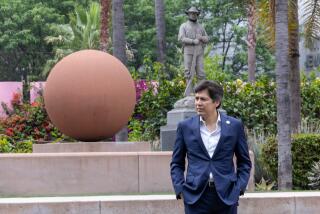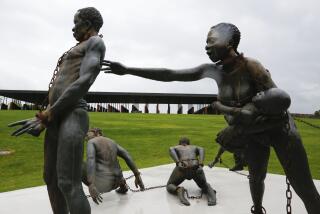‘Doc June’ Drew the Line on Safety
Frontier doctor June McCarroll’s legacy protects drivers even today, more than 80 years after her inspiration that center lines would improve highway safety. It took years for her idea to be accepted but she refused to quit, campaigning relentlessly with words and even a paintbrush.
A five-mile stretch of Interstate 10 in Indio was named for her last year. The Riverside County physician from the early 20th century joins hundreds of notables honored along the car culture’s arteries. In fact, the state’s 15,000 miles of highways are a virtual bumper-to-bumper Who’s Who.
Seldom has a government program had more direct effect on the lives of ordinary people than center lines. And all because she was run off the road once too often.
“When I gave this idea to an accident-ridden world,” McCarroll said years later, “it was with no thought of honors -- only safety for drivers of automobiles.”
A tiny, tough-talking lady who often strapped on a six-shooter to make house calls, McCarroll was one of the Imperial and Coachella Valley’s first female doctors. She visited patients by horse and buggy or rail, and for several years was the only physician officially designated to care for tens of thousands of Cahuilla Indians.
Little is known of her early life. She was born June Hill in Kentucky two years after the Civil War and graduated from the Allopathic Medical College of Chicago around 1888, at age 21.
After working two years with the Nebraska State Schools, she married a man named John Robertson and doctored folks on the side. But around the turn of the century, when her husband came down with tuberculosis, they headed for Los Angeles’ warmer, drier climate. She was determined to cure her husband of “consumption,” which at the time was one of the world’s deadliest infectious diseases.
On the way West in 1904, they stopped at a tuberculosis health camp near Indio that had been founded by Illinois manufacturer N.O. Nelson and Job Harriman, a tubercular preacher turned Socialist labor attorney.
Harriman had lost hard-fought elections for California governor in 1898 and for U.S. vice president in 1900 (as the running mate of Socialist Eugene V. Debs). Discouraged by conventional two-party politics, he tried to regain his strength in the desert, leading a small group to a 60-acre farm with about a dozen wooden buildings and tents.
Harriman’s strength had returned by 1904, so he left the farm in the hands of the Robertsons. That freed him to travel, increase his influence and prepare for the 1911 Los Angeles mayoral election -- which was no more successful than his earlier bids for public office.
Doc June cared for residents of the camp and for neighbors, making house calls by horse-drawn buggy. Sometimes she even pumped her way along the rails on a handcar. When Southern Pacific Railroad’s doctor quit, McCarroll took over his job too.
Primitive conditions did not discourage her.
“I would clear off the kitchen table, tie the patient down and administer anesthetic” and proceed with the operation, she once explained.
Surgery was what Doc June did best. Her most common operation was tonsillectomy.
In 1907, she founded the Coachella Valley’s first library to provide her TB patients with reading material, because they were quarantined in the middle of the desert.
That same year, the Bureau of Indian Affairs appointed her to care for the Cahuilla Indians. When she arrived at the reservations, there was no hospital, no nurse, no electricity and virtually no medical equipment. At least there was running water. But she was the only physician.
Doc June would become the first white “medicine woman” to responsibly serve one of the largest Native American tribes, which was spread out on five reservations.
A 1908 measles epidemic put her at odds with some of the band’s most powerful medicine men, who resented her intrusion. At the time, Cahuilla children were sent to school off the reservations, but many were returned to their families dying of tuberculosis or measles.
But soon her medical skills, along with her endless energy, compassion and no-nonsense manner, won them over, including tribal shaman Ambrosio Costillo.
Costillo worked day and night with Doc June, administering medicine and demonstrating the importance of sanitation and quarantine. He even warned her of a possible uprising by members of the tribe who were angry about the measles epidemic. She calmly strapped on a six-shooter and continued to combat suffering. No one, it seemed, questioned her courage -- nor her shooting ability.
In 1916, two years after her husband’s death, she married Southern Pacific Railroad station agent Frank McCarroll. Within a few years, as more doctors opened practices in Indio and the Coachella Valley, she semi-retired in the corner of barren desert where Joshua trees claw at the sky.
In 1917, she was driving home at dusk after visiting a patient when a truck forced her off a narrow highway into the sand. It wasn’t the first time. The truck driver apparently had difficulty telling just where his half of the unmarked highway ended.
Later, while driving on another, newer highway, she noticed that the road had a definite middle joint where it had been widened from 8 feet to 16. The pronounced center ridge caused cars to stay on their own side. A center line painted down the middle would serve the same purpose, she decided.
Known for confidence and straight talk, she took her idea to the Riverside County Board of Supervisors and the Chamber of Commerce. They gave her a polite ear but nothing else.
She took direct action: She got down on her hands and knees and painted a 2-mile-long, 4-inch-wide white stripe down the center of the road that passed in front of her house on Indio Boulevard.
She was sure that her example would illustrate the idea’s safety benefits, but change was slow to come. For seven years, she wrote letters and petitioned the county and state to adopt the white lines.
Finally, with the support of the Indio Women’s Club and the California Federation of Women’s Clubs -- which had previously campaigned to add roadside markers and to preserve El Camino Real -- she prevailed. In 1924, the Legislature authorized the State Highway Commission to paint center lines.
From Doc June’s idea sprang colors, stripes and other markings on streets and highways to enhance motoring safety. By the time she died in 1954, at 86, striping highways was commonplace across the country.
Recently, the Billy Holcomb chapter of E Clampus Vitus, a fun-loving but serious group of history buffs, etched the story of Doc June onto a bronze plaque. This weekend members will attach it to a six-foot-high concrete pillar in Indio, at the corner of Smurr Street and Indio Boulevard.
The chapter, founded in 1969, has erected 112 plaques in Riverside and San Bernardino counties. The sites are selected by the state Office of Historic Preservation, but chapter president Gary Bancroft -- whose official title in the Clampers is Noble Grand Humbug -- has researched the information for several of them.
Bancroft takes his task seriously.
“This is not history like World War II, or history with a capital H,” he said. “But it is history.”
More to Read
Sign up for Essential California
The most important California stories and recommendations in your inbox every morning.
You may occasionally receive promotional content from the Los Angeles Times.










